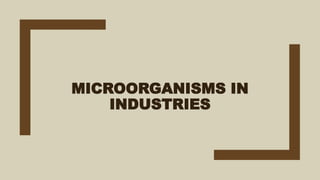
Industrial Microorganisms.pptx
- 2. CLASSIFICATION OF LIVING ORGANISMS INTO THREE DOMAINS
- 3. ADVANTAGES OF MICROORGANISMS OVER PLANTS OR ANIMALS 1. Microorganisms Grow rapidly in Comparison with Plants and Animals. 2. The Space Requirement for Growth of Microorganisms is Small. 3. Microorganisms are not subject to the Problems of the Vicissitudes of Weather. 4. Microorganisms are not affected by Diseases of Plants and Animals.
- 4. TAXONOMIC GROUPING OF INDUSTRIAL MICROORGANISM 1: BACTERIA 1.1 The Proteobacteria 1.1.1 The Acetic Acid Bacteria 1.2 The Firmicutes 1.2.1 Spore forming firmicutes 1.2.2 Non-spore forming firmicutes 1.3 The Actinobacteria 1.3.1 The Actinomycetes 2: EUCARYA: FUNGI 2.1 Phycomycetes 2.2 Ascomycetes 2.3 Fungi Imprfectie 2.4 Basidiomycetes
- 5. BACTERIA
- 6. 1.1 PROTEO-BACTERIA 1.1.1 ACETIC ACID BACTERIA • All Proteobacteria are Gram-Negative • Most Members are Facultatively or Obligately Anaerobic • Proteobacteria are Divided into Five Groups: α (Alpha), β (Beta), ɣ (Gamma), δ (Delta), ε (Epsilon) • The Industrially important Members : Acetobacter and Gluconobacter Acetobacter (Peritrichously Flagellated) Gluconobacter (Polarly Flagellated) • They Stand in Acid Conditions of pH 5.0 or Lower • They carry out incomplete Oxidation of Alcohol leading to the Production of Acetic acid
- 7. Acetobacter lacks Complete Citric Acid Cycle and can not oxidize Acetic Acid Gluconobacter has all Citric Acid enzymes and can oxidize Acetic Acid further to CO2. Their property of ‘Under-Oxidizing’ Sugars is exploited in the following: • The production of Glucoronic Acid from Glucose, Galactonic Acid from Galactose and Arabonic Acid from Arabinose • The production of Sorbose from Sorbitol by Acetic Acid Bacteria , an important stage in the Manufacture of Ascorbic Acid (Vitamin C)
- 9. PRODUCTS FROM ACETIC ACID BACTERIA 1. Glucoronic Acid from Glucose 2. Arabonic Acid from Arabinose 3. Galactonic Acid from Galactose 4. Sorbose from Sorbitol 5. Pure Cellulose 6. Acetic Acid or Vinegar
- 10. 1.2 THE FIRMICUTES • All Firmicutes are Gram-Positive • The Industrially Important Members are divided into Three major groups: o Spore-Forming Firmicutes o Non-Spore Forming Firmicutes o Wall-Less (Pathogens) 1.2.1 SPORE FORMING FIRMICUTES The Group is divided into Two: Bacillus spp, which are Aerobic and Clostridium spp which are Anaerobic. • Bacillus spp are sometimes used in Enzymes and Insecticide Production • Clostridia are Pathogens of Humans and Animals • B. papilliae infects and kills the Larvae of the Beetles • B. thuringiensis is used against Mosquitoes
- 11. 1.2.2 NON-SPORE FORMING FIRMICUTES The Lactic Acid Bacteria : • Shape: Rods or Cocci • Genera: Enterococcus, Lactobacillus, Lactococcus, Leuconostoc, Pediococcus and Streptococcus • Lactic Acid Bacteria are divided into Two Major Groups: 1. Homofermentative Group, which produce Lactic Acid as the Sole Product of the fermentation of Sugars 2. Heterofermentative Group, which produce Ethanol, as well as CO2. The Firmicutes Group are very Important in Industry as they contain the Lactic Acid Bacteria
- 14. The Desirable Characteristics of Lactic Acid Bacteria as Industrial Microorganisms include: Their Ability to Rapidly and Completely Ferment Cheap Raw Materials Their Minimal Requirement of Nitrogenous Substances They produce High Yields of the much preferred Stereo Specific Lactic Acid Ability to Grow under conditions of low pH and High Temperature Ability to Produce Low Amounts of Cell Mass USE OF LACTIC ACID BACTERIA FOR INDUSTRIAL PURPOSES:
- 15. 1.3 THE ACTINO-BACTERIA • The Acinobacteria have GC Content of 50% or higher. • Many Members of the Group have the Tendency to form Filaments or Hyphae. • The industrially important Members : o Pediococcus required in Lambic Beer o Leuconostoc involved in the Pickling of Vegetables, produce Dextrans from Sucrose o Lactococcus and Streptococcus used as Starter in Yoghurt Manufacture o Enterococcus used to Monitor Water Quality (like E. coli)
- 16. 1.3 ACTINO-BACTERIA 1.3.1 THE ACTINOMYCETES Branching Filamentous Hyphae, which Somewhat Resembles the Mycelia of Fungi Petidoglycan in their Cell walls and Second they are about 1.0 -1.5 µ in Diameter They produce Secondary Metabolites (like Antibiotics) which are of Industrial Importance, especially as Pharmaceuticals
- 17. EUCARYA FUNGI
- 18. 2. EUCARYA: FUNGI Fungi are Traditionally Classified into Four Groups 1. Phycomycetes 2. Ascomycetes 3. Fungi Imprfecti 4. Basidiomycetes 2.1 PHYCOMYCETES Industrially Important Members are Rhizopus and Mucor which are used for Producing Various Enzymes Mucor Rhizopus
- 19. 2.2 ASCOMYCETES • Yeasts are used for the Production of Ethanol and Alcoholic Beverages • Claviceps purperea is used for the Production of the Ergot Alkaloids
- 20. 2.3 FUNGI IMPRFECTIE Aspergillus is important Because it Produces the Food Toxin, Aflatoxin Penicillium is well-known for the Antibiotic Penicillin which it Produces.
- 21. 2.4 BASIDIOMYCETES Agaricus Produces the Edible Fruiting Body or Mushrooms